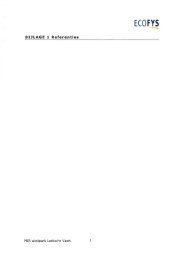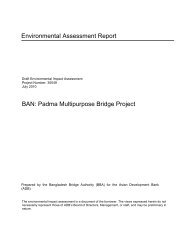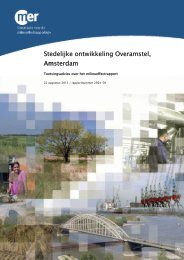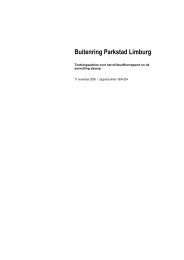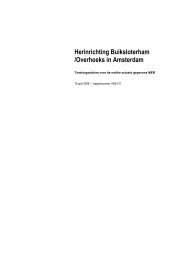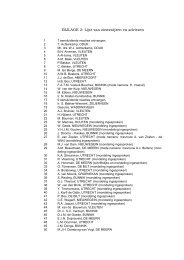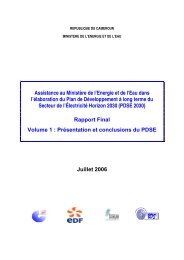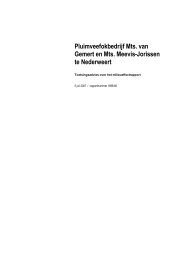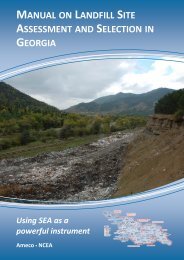A generic approach to integrate biodiversity ... - ResearchGate
A generic approach to integrate biodiversity ... - ResearchGate
A generic approach to integrate biodiversity ... - ResearchGate
Create successful ePaper yourself
Turn your PDF publications into a flip-book with our unique Google optimized e-Paper software.
Environmental Impact Assessment Review23 (2003) 657–681www.elsevier.com/locate/eiarA <strong>generic</strong> <strong>approach</strong> <strong>to</strong> <strong>integrate</strong> <strong>biodiversity</strong>considerations in screening and scoping for EIARoel Slootweg a, *, Arend Kolhoff b,1a Slootweg en van Schooten Natural and Human Environment Consultants, Juffermansstraat 5,Oegstgeest 2341 JH, The Netherlandsb Netherlands Commission for Impact Assessment, P.O. Box 2345, Utrecht 3500 GH, The NetherlandsReceived 1 February 2003; received in revised form 1 May 2003; accepted 1 May 2003AbstractThe Convention on Biological Diversity (CBD) requires parties <strong>to</strong> apply environmentalimpact assessment (EIA) <strong>to</strong> projects that potentially negatively impact on <strong>biodiversity</strong>. Asmembers of the International Association of Impact Assessment, the authors have developeda conceptual framework <strong>to</strong> <strong>integrate</strong> <strong>biodiversity</strong> considerations in EIA. By defining<strong>biodiversity</strong> in terms of composition, structure, and key processes, and by describing the wayin which human activities affect these so-called components of <strong>biodiversity</strong>, it is possible <strong>to</strong>assess the potential impacts of human activities on <strong>biodiversity</strong>. Furthermore, the authorshave translated this conceptual framework in <strong>generic</strong> guidelines for screening and scoping inimpact assessment. Countries can use these <strong>generic</strong> guidelines <strong>to</strong> further operationalise theframework within the existing national procedures for impact assessment. This paper is fullycoherent and partly overlapping with the guidelines recently adopted by the CBD, but differsin the sense that it provides more scientific background and is less policy-oriented.D 2003 Elsevier Inc. All rights reserved.Keywords: EIA; Biodiversity; Screening; Scoping; CBD1. IntroductionArticle 14 of the Convention on Biological Diversity (CBD) requires parties <strong>to</strong>apply environmental impact assessment (EIA) <strong>to</strong> projects that potentially nega-* Corresponding author. Tel.: +31-71-5283858; fax: +31-71-5283859.E-mail addresses: SevS@SevS.nl (R. Slootweg), Akolhoff@eia.nl (A. Kolhoff).1 Tel.: +31-30-2347604, +31-30-2347666; fax: +31-30-2304382.0195-9255/03/$ – see front matter D 2003 Elsevier Inc. All rights reserved.doi:10.1016/S0195-9255(03)00114-8
658R. Slootweg, A. Kolhoff / Environ. Impact Asses. Rev. 23 (2003) 657–681tively impact on <strong>biodiversity</strong> and <strong>to</strong> apply appropriate procedures for programmesand policies that potentially negatively impact <strong>biodiversity</strong>. Subsequentdecisions of the Conferences of the Parties (COP) <strong>to</strong> the CBD have recognisedthat in order <strong>to</strong> adequately implement this article, further consideration should begiven on how <strong>biodiversity</strong> can be <strong>integrate</strong>d with impact assessments (CBD,2001).In order <strong>to</strong> respond <strong>to</strong> this request, a conceptual and procedural framework forthe integration of <strong>biodiversity</strong> considerations within national systems for impactassessment has been produced by the authors and discussed among members ofthe Ecology and Biodiversity section, one of the specialised member forums ofthe International Association for Impact Assessment (IAIA) (Slootweg andKolhoff, 2001). The framework concentrates on the screening and scoping stepsfor project-level EIA. This framework provided a basis for the secretariat of theConvention on Biodiversity <strong>to</strong> produce, in close collaboration with the authors,draft guidelines for incorporating <strong>biodiversity</strong>-related issues in<strong>to</strong> environmentalimpact assessment legislation and/or processes and in strategic environmentalassessment. The 6th Conference of Parties of the CBD endorsed these draftguidelines (decision VI/7) and urged parties, other governments, and organisations<strong>to</strong> apply the guidelines (CBD, 2002). Two other <strong>biodiversity</strong> conventionshave included the guidelines (Ramsar Wetland Convention by Resolution VIII.9)or have referred <strong>to</strong> the CBD guidelines (Convention on Migra<strong>to</strong>ry Species byResolution 7.2).This paper is completely coherent with the CBD guidelines, but the focus issomewhat different. While the CBD guidelines focus on procedures andpolicies, this paper provides a description of the theoretical concepts behindthe COP decision VI/7 and provides further details on the proposed proceduralsteps for screening and scoping in project-level environmental impact assessment.The reason <strong>to</strong> first elaborate on the screening and scoping stages of theEIA process is that these steps define the whole EIA process; the decision onfurther study is taken with a screening decision and the issues <strong>to</strong> be studied inEIA are identified in the scoping stage. As requested by CBD decision VI/7,further development and refinement of the guidelines are needed <strong>to</strong> incorporateall stages of the environmental impact assessment and strategic environmentalassessment processes.Slootweg et al. (2001) describe a comprehensive conceptual framework,designed <strong>to</strong> provide an understanding of the causal chains by which activitieslead <strong>to</strong> impacts, through biophysical and social pathways. The framework isintended <strong>to</strong> accommodate all conceivable biophysical and social impacts. In thisdocument, the framework has been elaborated in detail for the identification of<strong>biodiversity</strong>-related impacts. The use of an all-encompassing framework isdeliberate, so as <strong>to</strong> make sure that <strong>biodiversity</strong> is an integral part of existingimpact assessment procedures and legislation. In other words, no new instrumentnor procedure is proposed; the proposed <strong>approach</strong> can be accommodated withexisting procedures.
R. Slootweg, A. Kolhoff / Environ. Impact Asses. Rev. 23 (2003) 657–681 659Treweek (1999) indicated that the inconsistency of methodologies and ofreporting on methodologies and results has, among other reasons, seriouslyhampered the accumulation of one body of relevant experience and knowledge inthe prediction of impacts on <strong>biodiversity</strong>. It is hoped that this framework canprovide a <strong>to</strong>ol <strong>to</strong> promote greater consistency in addressing issues related <strong>to</strong><strong>biodiversity</strong> in EIA. This paper is addressing the scientific and impact assessmentcommunities in countries that intend <strong>to</strong> improve the performance of their EIAinstrument with respect <strong>to</strong> <strong>biodiversity</strong>. The paper does not provide a fixedprocedure or predictive model; moreover, it provides a way of thinking on how<strong>biodiversity</strong> can be better embedded in existing EIA systems. As each countryhas its own biological, social, legal, and administrative characteristics, it is up <strong>to</strong>the countries <strong>to</strong> take up the challenge <strong>to</strong> adapt their EIA systems for betterconservation and use of <strong>biodiversity</strong>.2. The general frameworkIn Fig. 1, the general framework, as described by Slootweg et al. (2001), ispresented. The framework provides a sequence of steps <strong>to</strong> determine the impactsthat may result from a (proposed) activity. The starting point of analysis is anactivity that can be a biophysical or a social intervention. (Bear in mind that aproposed project can be composed of a large number of different activities.) Thesteps that follow are described below:(A) Biophysical interventions lead <strong>to</strong> biophysical changes being defined aschanges in the characteristics of the recipient media soil, water, air, flora, andfauna (e.g., a dam changes river hydrology).(B) Each direct biophysical change can result in a chain of second-order andhigher-order biophysical changes (e.g., a reduction in river flow will result inFig. 1. General framework (adapted from Slootweg et al., 2001).
660R. Slootweg, A. Kolhoff / Environ. Impact Asses. Rev. 23 (2003) 657–681reduced submersion of downstream floodplains, which may in turn influencethe recharge of groundwater aquifers under these plains, etc.).(C) Projects can also carry out social 2 interventions that lead <strong>to</strong> social changeprocesses being defined as changes in the characteristics of socialcomponents (individuals, families, functional groups, or a society as awhole); the nature of these characteristics can be demographic, economic,socio-cultural, emancipa<strong>to</strong>ry, institutional, land use, etc. (e.g., the constructionand operation of a dam can attract migrant workers).(D) Higher-order social change processes. Each direct social change process canlead <strong>to</strong> second-order and higher-order social change processes (e.g., inmigrationof foreign workers may lead <strong>to</strong> segregation, which in turn maylead <strong>to</strong> marginalisation).(E) Social change processes lead <strong>to</strong> biophysical changes. A change in the socialcharacteristics of a community can lead <strong>to</strong> biophysical changes (e.g.,population growth can lead <strong>to</strong> occupation and conversion of new land).(F) Most biophysical changes will only affect the area where the activity iscarried out; these are so-called onsite changes. However, a number ofbiophysical changes will have a wider area of influence and will causeoffsite changes. A knowledgeable expert will be capable of determiningthe geographical range of influence of these changes. Knowing thepotential area of influence, one can identify the ecosystems and land-usetypes that lie within the boundaries of the area of influence. Differentbiophysical changes can have different areas of influence; for eachexpected biophysical change, one has <strong>to</strong> define the area of influence anddetermine the ecosystems and land-use types that may potentially beinfluenced.(G) Each ecosystem or land-use type provides a unique set of functions that arevalued by society; these functions are often referred <strong>to</strong> as goods and servicesprovided by nature. Under the influence of biophysical changes, thesefunctions may change. Impacts are defined as the changes in the quality orquantity of the goods and services ( = functions) provided by an ecosystemor land-use type (including both biotic and abiotic environment). 3(H) A change in the functions provided by the natural environment will lead <strong>to</strong> achange in their value for human society. The function concept is principallyanthropocentric, translating nature in<strong>to</strong> functions for human society. Societyputs a value on these functions. Biodiversity provides functions that areconverted in<strong>to</strong> use and nonuse values <strong>to</strong> human society. Values can beexpressed in economic, social, or ecological terms.2 The term ‘‘social’’ is used in the broad sense, thus also including cultural, economic, andinstitutional aspects (for further details, see van Schooten et al., in press; Vanclay, 2001).3 We use the functions of nature concept as described by de Groot (1992), distinguishing fourcategories of functions: production, processing and regulation, carrier, and significance functions.More on this in relation <strong>to</strong> the presented framework is provided by Slootweg et al. (2001).
R. Slootweg, A. Kolhoff / Environ. Impact Asses. Rev. 23 (2003) 657–681 661(I) Social change processes cause social impacts (not within the scope of thispaper; see van Schooten et al., 2003).(J) As human beings or society as a whole are able <strong>to</strong> respond <strong>to</strong> impacts, theexperience of social impacts, in some cases, leads <strong>to</strong> so-called invoked socialchanges processes (e.g., people may decide <strong>to</strong> move elsewhere after theemergence of social tensions, or when productivity of natural resourcesdiminishes).In the framework, a rigid distinction is being made between ‘‘changes’’ or‘‘change processes’’ and ‘‘impacts.’’ Biophysical changes and social changeprocesses are defined as being independent of the context in which they occur.If an intervention is known <strong>to</strong> cause certain changes, these changes will alwaysoccur if a suitable recipient is present. Magnitude and direction of change aredetermined by the combined characteristics of the intervention and the recipientinvolved. Biophysical changes and social change processes can—if the state oftechnology allows so—be predicted, measured, and quantified by external experts.Contrary <strong>to</strong> changes or change processes, impacts (biophysical as well associal) are considered <strong>to</strong> be context-dependent. Functions of the natural environmentare determined by the type of ecosystem or land-use type, wherebiophysical changes occur, and by the level of recognition of these functionsby society (i.e., their occurrence depends on the context in which one works).One has <strong>to</strong> know the exact nature of the ecosystem or land-use type wherebiophysical changes occur and one has <strong>to</strong> know the use that society makes use ofthese functions (including people’s perception of these functions). Outsideexperts will be capable of defining most functions of known ecosystems orland-use types. Yet, whether these functions are actually valued by society, andthus should be included in EIA studies, is completely dependent on the societalcontext. This relates <strong>to</strong> the norms and values system of a society, represented byits laws and regulations (cus<strong>to</strong>mary rules or formalised legislation). 4The important consequence of this notion of context dependency is thatimpacts cannot be determined by external experts only, but that stakeholders have<strong>to</strong> be consulted. For the purpose of conservation of <strong>biodiversity</strong>, this is of extremeimportance because if one does not know the perception of <strong>biodiversity</strong> among asociety, it will be very difficult <strong>to</strong> take in<strong>to</strong> account and explain matters related <strong>to</strong>nature conservation in EIA studies and, even more difficult so, during projectimplementation. Furthermore, groups in society may adhere different values <strong>to</strong><strong>biodiversity</strong>, which potentially leads <strong>to</strong> conflicting interests. EIA is the <strong>to</strong>ol4 Society, of course, is not a single entity. Perceptions and values will differ at different levels ofsociety (e.g., the local, regional, national, and international society). Similarly, differences will existbetween groups within society. Special reference should be made <strong>to</strong> indigenous people whosetraditional uses and knowledge of <strong>biodiversity</strong> are referred <strong>to</strong> in Article 8(j) of the <strong>biodiversity</strong>convention. Stakeholder representation in the EIA process has <strong>to</strong> guarantee that these aspects are takenon board. Legal mechanisms have <strong>to</strong> guarantee this representation.
662R. Slootweg, A. Kolhoff / Environ. Impact Asses. Rev. 23 (2003) 657–681designed <strong>to</strong> provide insight in these potential conflicts in an early stage, so thatalternative, mitigative, or compensa<strong>to</strong>ry measures can be taken.3. The scope of <strong>biodiversity</strong>A fundamental question is: ‘‘What exactly is considered <strong>to</strong> be <strong>biodiversity</strong>and, consequently, what needs <strong>to</strong> be put under the heading <strong>biodiversity</strong> in EIAprocedures and studies?’’ The definition of the CBD states, ‘‘Biological diversitymeans the variability among living organisms from all sources, inter alia,terrestrial, marine, and other aquatic ecosystems and the ecological complexesof which they are part; this includes diversity within species, between species,and of ecosystems.’’ For the operationalisation of this definition in the context ofEIA, it will be necessary <strong>to</strong> concentrate on functions for the maintenance of<strong>biodiversity</strong> and the nonuse values derived from these, and the impacts ofbiophysical and social change on these functions and values.However, Article 10 of the convention, referring <strong>to</strong> sustainable use ofcomponents of <strong>biodiversity</strong>, would require a much wider view on <strong>biodiversity</strong>.In order <strong>to</strong> ‘‘protect and encourage cus<strong>to</strong>mary use of biological resources inaccordance with traditional cultural practises that are compatible with conservationor sustainable use requirements,’’ many of the functions of nature <strong>to</strong> whichsociety assigns use values would fall under the notion of <strong>biodiversity</strong>. Examplesof such functions are:(i) production functions that relate <strong>to</strong> harvestable products such as fish, wood,bush meat, medicinal plants, wild fruits and nuts, etc.(ii) processing and regulation functions that depend on, for example, organismsthat act as pollina<strong>to</strong>rs; biological control organisms in fruit plantations; thedecomposition of organic material/waste by many species of relativelyunknown invertebrates; etc.(iii) carrying functions provided by local ecosystems that determine the quality,health, and safety of the environment in which people live (mangrovesprotect coastal villages against s<strong>to</strong>rm surges, wetlands provide clean water,etc.)(iv) significant functions such as nature-based leisure and <strong>to</strong>urism activities, orsites of religious or scientific interest, etc.With respect <strong>to</strong> possible impacts on <strong>biodiversity</strong>, two questions thus have <strong>to</strong> beanswered in EIA studies:. For nonuse values related <strong>to</strong> <strong>biodiversity</strong>: Does the intended activity affect thephysical environment in such a manner or cause such biological losses that itinfluences the chance of extinction of cultivars, varieties, and populations ofspecies, or that it changes the quality of habitats or ecosystems?
R. Slootweg, A. Kolhoff / Environ. Impact Asses. Rev. 23 (2003) 657–681 663. For use values derived from <strong>biodiversity</strong>-related functions:– For production functions: Does the intended activity surpass the maximalsustainable yield of a resource, population, or ecosystem?– For processing and regulation functions, carrying functions, and significationfunctions: Does the intended activity surpass the maximum allowablelevel of disturbance?4. How <strong>to</strong> define impacts on <strong>biodiversity</strong>Above, it has been shown how a proposed activity leads <strong>to</strong> a number ofbiophysical changes (either directly, or through social change processes). It hasfurthermore been demonstrated that, having identified these changes, one candefine the geographical area where these changes occur, and thus one can make aninven<strong>to</strong>ry of types of landscapes (natural and seminatural ecosystems and land-usetypes) that could be influenced by the proposed activity. Having identified thelandscapes, the last step that remains is <strong>to</strong> describe these landscapes and identifythe possible impacts on <strong>biodiversity</strong> in these landscapes. 5The practical problems in describing the <strong>biodiversity</strong> of an area may beoverwhelming, in many cases due <strong>to</strong> lack of data, or else due <strong>to</strong> the sheeramount of data and the problem of selecting what is relevant information.However, the <strong>approach</strong>, as presented here, allows for the identification ofserious threats <strong>to</strong> the maintenance and use of <strong>biodiversity</strong>, even if one is notcapable of exactly describing this diversity at all three levels (genetic, species,and ecosystems). Ecological knowledge has progressed far enough <strong>to</strong> makecertain predictions, based on generally applicable knowledge and rules ofthumb.In order <strong>to</strong> be able <strong>to</strong> describe potential impacts on <strong>biodiversity</strong>, one otherconcept of diversity has <strong>to</strong> be introduced—the components of <strong>biodiversity</strong>.Biophysical changes may affect diversity at genetic, species, or ecosystemlevel. The problem, of course, is <strong>to</strong> identify the mechanism through which themaintenance of diversity works, and how biophysical changes can be ofinfluence. Based on various sources in the scientific literature, it is arguedhere that three essential features of <strong>biodiversity</strong> provide this ‘‘missing link.’’The <strong>approach</strong> is based on Noss’ (1990) classification of <strong>biodiversity</strong>, elaboratedby Le Maitre and Gelderblom (1998), and further operationalised by Koningand Slootweg (unpublished document). Each of the three levels of diversity(i.e., genetic, species, and ecosystem level) can be characterised and described5 The term ‘‘landscape,’’ as it is used here, does not refer <strong>to</strong> a fourth level of <strong>biodiversity</strong> asintroduced by landscape ecology. In this paper, the three levels defined by the CBD are used: genetic,species, and ecosystem. Moreover, it is a term combining natural ecosystems and heavily influencedtypes of land use.
664R. Slootweg, A. Kolhoff / Environ. Impact Asses. Rev. 23 (2003) 657–681in detail by answering three questions that refer <strong>to</strong> the components of<strong>biodiversity</strong>.. What is there (refers <strong>to</strong> the composition)?When describing the composition of <strong>biodiversity</strong> of an area, one describesflora and fauna and how abundant it is. In the general practice of EIAnowadays, the species composition of an area is often the only aspect that isconsidered. In a good analysis, composition also applies <strong>to</strong> ecosystem composition(types of ecosystems in the area) and when dealing with agro-<strong>biodiversity</strong>with genetic composition (availability of local varieties of cultivated plants andanimals).. How is it organised in space and time (refers <strong>to</strong> structure)?The structure describes how the elements of <strong>biodiversity</strong> are organised in timeand space. Three types of structure can be distinguished.Horizontal structure: spatial distribution of ecosystems, species, or geneticvariability (e.g., species and ecosystems may have a patchy distribution or canfollow gradient situations that create gradual changes from one ecosystem in<strong>to</strong>another).Vertical structure: the vertical structure is often related <strong>to</strong> strong verticaldifferentiation of physical parameters such as penetration of light, local temperature(thermocline), and oxygen (stratification) (e.g., forests are verticallylayered, each layer having its own communities of plants and animals). Plant andanimal communities in coastal zones vary distinctly with depth.Temporal structure: many species and ecosystems are adapted <strong>to</strong> cyclicphenomena such as seasonality (e.g., summer–winter, dry–wet season inrelation <strong>to</strong> breeding, flowering, migration, hibernation, etc.), tidal rhythm(mangroves, mud flats), diurnal rhythm (nocturnal animals), or lunar cycles(Chaoborus mosqui<strong>to</strong>es appearing at full moon). These phenomena can beregular (all of the above examples) or irregular, such as adaptations <strong>to</strong> prolongeddroughts or irregular fires.. What process(es) is (are) of key importance for its creation and maintenance(refers <strong>to</strong> physical, biological, or biophysical processes, i.e., key processes)?A relatively small set of plant, animal, and abiotic processes structuresecosystems across scales of time and space. A key process is defined as aprocess that plays a dominant role in structuring or maintaining ecological units(population, habitat, community, ecosystem, and landscape) and/or in structuringor maintaining processes between units. Key processes may be of a completelyabiotic nature, biotic nature, or a mix of both (e.g., plants and animals colonisenewly created habitats and live in so-called pioneer communities that are fully
R. Slootweg, A. Kolhoff / Environ. Impact Asses. Rev. 23 (2003) 657–681 665dominated by abiotic fac<strong>to</strong>rs: temperature, rainfall, soil quality, tidal rhythm,etc.); in contrast, climax situations create and regulate their own environment,and biotic processes dominate (e.g., seed dispersal in pioneer vegetation occurspredominantly by wind or water; in tropical rainforests, it occurs by birds, bats,and terrestrial mammals). Similarly, microclimatic conditions and nutrient supplyin pioneer vegetations are dominated by physical processes, while rainforestsmaintain their own microclimate and nutrient cycles. Other examples of keyprocesses are: natural fires and grazing, which are key processes in themaintenance of savannah systems; and yearly floods, which define floodplainecosystems. In areas with a long his<strong>to</strong>ry of human interference such as traditionalagricultural practises, man-driven processes responsible for maintaining sometimeshighly biodiverse landscapes can also be recognised. Examples are alpinepastures, heathlands, etc.If one knows the biophysical changes that can be expected from a proposedactivity and their area of influence (through technical studies, computer simulation,etc.), an experienced ecologist can determine how these biophysical changeswill interact with the components of diversity and how this may affect theecosystem or land-use types within the area influenced by the biophysicalchange. Due <strong>to</strong> the high interconnectedness within and between ecosystems,most biophysical changes will result in a cascade-like chain of events. Therefore,it is important <strong>to</strong> identify the first point where such a chain of events starts. Box 1provides some examples.Box 1. Some examples of how human interventions interact with componentsof <strong>biodiversity</strong>. Example 1—composition and spatial structure.Selective logging in primary forest will influence the species compositionof the forest ecosystem and will change the spatial distribution (structure) ofthe logged species (for reasons of simplicity of the example, the directdamage being done by falling trees and the logistics of logging is not takenin<strong>to</strong> account).. Example 2—spatial structure.New line infrastructures such as roads and railways cut through existingecosystems. For many invertebrates and smaller vertebrates, this impliesbeing split up in<strong>to</strong> two reproductively isolated populations. If the originalecosystem was small, the splitting up may result in the creation of twopopulations that both are under the minimal viable population threshold,will suffer from genetic erosion, and, in the end, will disappear. In turn, thedisappearance of one or a few species will cause other <strong>biodiversity</strong>-relatedimpacts on the ecosystem level, but the initia<strong>to</strong>r changed the spatialstructure of the populations and its effect at the genetic level.
666R. Slootweg, A. Kolhoff / Environ. Impact Asses. Rev. 23 (2003) 657–681. Example 3—temporal structure.Proposed dredging activities in a wetland area coincided with thereproductive season for marine bivalves of economic (fisheries) andecological (food for shorebirds) importance. The turbidity caused by thedredging would cause massive death of young bivalves. Rescheduling ofthe dredging activities <strong>to</strong> a later season was enough <strong>to</strong> avoid greatecological and economic damage.. Example 4—key process (abiotic).The damming of a river results in reduced discharge of sediments in theriver’s estuary. The sediment balance in the estuary is upset, causingmassive erosion of the mangrove ecosystem, in turn reducing the numbersof fish and shellfish that breed in the mangroves, and thus decreasing thenumbers of waderbirds that prey upon these organisms, etc. The physicalchange of reduced sediment discharge in the estuary affected the keyprocess of maintaining a delicate balance in sediment deposition andremoval in an estuarine mangrove ecosystem.. Example 5—key process (biotic).A man-made wetland in the Netherlands has, unintendedly, become aRamsar site of international importance due <strong>to</strong> the presence of tens ofthousands of wintering geese that have s<strong>to</strong>pped the succession of wetreedlands in<strong>to</strong> dry shrubland. By intensive grazing, the shallow openwater did not get a chance <strong>to</strong> grow over and peat formation largelys<strong>to</strong>pped. The intended conversion of the area in<strong>to</strong> a business park has beencancelled and it has become a national reserve. (The intended biophysicalchange, creation of new land, was effectively s<strong>to</strong>pped by geese, thuscreating a new ecosystem due <strong>to</strong> the introduction of a key structuringprocess.)The examples in Box 1 show that it is possible <strong>to</strong> make statements aboutpossible impacts on <strong>biodiversity</strong> without detailed knowledge of the speciescomposition and abundance in the ecosystems. After having established thepossible impact mechanisms, one is better able <strong>to</strong> define exactly the researchquestions that need <strong>to</strong> be dealt with in an EIA study.5. Applying the concepts <strong>to</strong> practise: screeningScreening is intended <strong>to</strong> determine which proposed new projects need furtherenvironmental consideration, <strong>to</strong> exclude those unlikely <strong>to</strong> have harmful environmentalimpacts, and <strong>to</strong> indicate the level of environmental appraisal that a projectwill require. Information required for screening should be available in thesubmitted project description; lacking or additional information may be obtainedfrom the proponent or by a field visit.
R. Slootweg, A. Kolhoff / Environ. Impact Asses. Rev. 23 (2003) 657–681 667Considering the dual objective of the CBD on conservation and sustainableuse of <strong>biodiversity</strong>, two fundamental questions need <strong>to</strong> be answered in an EIAstudy:Does the intended activity affect the physical environment in such a manner, orcause such biological losses that it influences the chance of extinction ofcultivars, varieties, populations of species, or the chance of loss of habitats orecosystems (i.e., leading <strong>to</strong> the loss of <strong>biodiversity</strong>—issues related <strong>to</strong> theconservation of <strong>biodiversity</strong>)?Does the intended activity surpass the maximal sustainable yield or themaximum allowable disturbance level of a resource, population, or ecosystem(i.e., leading <strong>to</strong> a reduction or loss of use functions derived from <strong>biodiversity</strong>—issues related <strong>to</strong> sustainable use of <strong>biodiversity</strong>)?The two questions above have <strong>to</strong> be further elaborated on the three levels of<strong>biodiversity</strong> (genetic, species, and ecosystem diversity), and qualitative orquantitative criteria are needed for decision making. To facilitate the developmen<strong>to</strong>f criteria, the two questions above have been expanded for the three levels ofdiversity. This results in a set of questions that realistically covers all relevantaspects of <strong>biodiversity</strong> at the screening stage (adapted from Kolhoff, 2000).5.1. Genetic diversityGenetic diversity refers <strong>to</strong> both natural diversity and diversity in agriculturalvarieties created by human activities. As agriculture is a <strong>to</strong>tally controlledactivity, it can be expected that the potential loss of traditional/local varietiesand breeds can simply be determined on the basis of a project description. In thiscase, it makes no sense <strong>to</strong> make a distinction between impacts on diversity orimpacts on sustainable use, since agro-<strong>biodiversity</strong> inherently covers both issuessimultaneously.The pertinent screening question with respect <strong>to</strong> agro-<strong>biodiversity</strong> thus is:I. Does the intended activity cause a local loss of varieties/cultivars/breeds ofcultivated plants and/or domesticated animals?The potential loss of natural genetic diversity (genetic erosion) is extremelydifficult <strong>to</strong> determine and it does not provide any practical criteria <strong>to</strong> come <strong>to</strong> ascreening decision. The issue probably only comes up when dealing with highlythreatened, legally protected species, which are limited in numbers and/or havehighly separated populations (rhino’s, tigers, whales, etc.), or when completeecosystems become separated and the risk of genetic erosion applies <strong>to</strong> manyspecies (the reason <strong>to</strong> construct so-called ecoducts across major line infrastructure).These issues are dealt with at species or ecosystem level. The introduction ofgenetically modified organisms is a <strong>to</strong>tally new and rapidly developing theme.
668R. Slootweg, A. Kolhoff / Environ. Impact Asses. Rev. 23 (2003) 657–681Usually this is dealt with under the heading of introduction of exotic species, thus atspecies level.5.2. Species diversityFor conservation and sustainable use of <strong>biodiversity</strong> at species level, thefollowing pertinent questions should be answered at the screening stage:II. Does the intended activity cause a loss of a population of a species?III. Does the intended activity affect the sustainable use of a population of aspecies?The definition of the level at which ‘‘population’’ is <strong>to</strong> be defined fully dependson the screening criteria a country or organisation uses. For example, certain plantspecies are considered <strong>to</strong> be ‘‘rare’’ in the Netherlands, simply because only somefringes of the highlands <strong>to</strong> which these species belong can be found in the country.From a European perspective, these species are relatively common. Yet, thegovernment considers these species <strong>to</strong> be valuable and, within the Dutch terri<strong>to</strong>ry,the few populations should be maintained. The conservation status of a speciesthus can differ, depending on perspective: It can be assessed within the boundariesof a country (for legal protection), or can be assessed globally from a biologists’perspective (e.g., see the IUCN, 2001 red list of threatened species).5.3. Ecosystem diversityAt the ecosystem level of <strong>biodiversity</strong>, the following pertinent questionsshould be answered at the screening stage:IV. Does the intended activity lead <strong>to</strong> serious damage or <strong>to</strong>tal loss of (an)ecosystem(s) or land-use type(s), thus leading <strong>to</strong> a loss of ecosystemdiversity?V. Does the intended activity affect the sustainable exploitation of (an)ecosystem(s) or land-use type(s) by humans in such manner that theexploitation becomes destructive or nonsustainable?5.4. Translate screening questions in<strong>to</strong> criteriaFor each of questions I–V, practical criteria need <strong>to</strong> be developed. Thepresented conceptual framework can be used for the identification of screeningcriteria. Very often, criteria relate <strong>to</strong> the biophysical changes that result from anactivity. For example, standards for water quality apply <strong>to</strong> all activities thatproduce waste water effluent, and usually indicate a maximally accepted level ofpollution. The problem with, for example, water quality standards is that they aredesigned for a limited number of functions of water (i.e., water for human use:
R. Slootweg, A. Kolhoff / Environ. Impact Asses. Rev. 23 (2003) 657–681 669household supply or recreational activities). The criteria have not been designed<strong>to</strong> consider other functions such as maintenance of <strong>biodiversity</strong>.By going stepwise through the framework for different categories of activitiesand describing their potential impacts on <strong>biodiversity</strong> through changes in thebiophysical environment, it is possible <strong>to</strong> identify criteria and norms relevant <strong>to</strong><strong>biodiversity</strong> (see Fig. 1). In this paper, we provide pathways of thinking for theidentification and technical design of sets of criteria; the weighting process thatresults in norms and threshold values is a political process of which the outcomemay vary for countries and (ideally) even for ecosystems.5.4.1. Interventions and biophysical changesProjects involve biophysical and social interventions. These will lead <strong>to</strong> directbiophysical and social changes, which in turn may lead <strong>to</strong> higher-order changes.The description of activities and the resulting direct changes would take in<strong>to</strong>account characteristics such as type or nature of activity, magnitude, extent/location, timing, duration, reversibility/irreversibility, likelihood, and significance.Furthermore, good technical design not only takes in<strong>to</strong> account the directeffects, but will also look for indirect effects (e.g., the indirect biophysicalconsequences of social changes such as relocation of people, or the plannedinflux of migrant workers needing housing facilities; cumulative and synergisticeffects and possibly residual effects if the project document already includesproposed mitigation measures on some of the interventions).5.4.2. Area of influenceIf one knows the biophysical changes that will result from the proposedactivity and if the influence of these changes can be modelled or predicted, thearea of influence can be determined.5.4.3. Ecosystems and land-use types under influence and expected impacts on<strong>biodiversity</strong>Since the area of influence of the proposed activity is known, the influencedland-use types or ecosystems can be determined. Subsequently, the impacts on<strong>biodiversity</strong> can be determined.Having determined (categories of) activities, biophysical changes, area ofinfluence, and impacts on <strong>biodiversity</strong>, now the best possible screening criteriahave <strong>to</strong> be determined with unequivocal decision rules. This is a process in whichscientists, responsible government agencies, and political decision makers allhave an important say. The criteria should be scientifically valid, applicable <strong>to</strong>day-<strong>to</strong>-day EIA reality, and provide sound information for decision making.Examples of different types of screening criteria are:Activities: Magnitude of the activity, surface area occupied, <strong>to</strong>nnage ofproduce, amounts or types of raw materials used, use of specific technology,introduction of species, etc.
670R. Slootweg, A. Kolhoff / Environ. Impact Asses. Rev. 23 (2003) 657–681 Biophysical changes: Level of air emissions or noise, maximum allowablechange in water quality, etc. Area of influence: Urban and rural planning schemes or zoning regulationscan provide a good reference for screening of projects. It provides a legal basisfor restrictions related <strong>to</strong> geographically known areas [in many cases related <strong>to</strong>specific types of activities, or types of influence (through biophysical changes)that activities exert on designated areas]. Ecosystems or land-use types: For specified types of land-use or ecosystems,criteria can be designed; these may also relate <strong>to</strong> elements of these such asprotected species known <strong>to</strong> occur in certain ecosystems, or landscape elementsin certain land-use types. A spatial scale of reference should be set (e.g.,provincial, regional, etc.), against which <strong>to</strong> measure the significance of theimpact (i.e., of the loss of ecosystem diversity). This is especially crucial forquestion V on sustainable exploitation. The word ‘‘sustainable’’ becomesmeaningful only in relation <strong>to</strong> a specific scale of analysis.Box 2 provides a <strong>generic</strong> set of screening criteria, representing a mix of thecategories above.Box 2. A suggested set of screening criteria <strong>to</strong> be elaborated on countrylevel. It only deals with <strong>biodiversity</strong> criteria and thus is an add-on <strong>to</strong>already existing screening criteria (reproduced from Slootweg and Kolhoff,2001; CBD, 2002)Category A: Environmental impact assessment manda<strong>to</strong>ryOnly in this case, criteria can be based on formal legal backing such as: National legislation (e.g., in case of impact on protected species andprotected areas) International conventions such as CITES, the Convention onBiological Diversity, Ramsar Convention on Wetlands, etc. Directives from supranational bodies, such as the European Uniondirective 92/43/EEC of May 21, 1992 on conservation of natural habitatsand of wild fauna and flora, and directive 79/409/EEC on theconservation of wild birds.Indicative list of activities for which an environmental impact assessmentcould be manda<strong>to</strong>ry:(a) At genetic level:. Directly or indirectly cause a local loss of legally protected varieties/cultivars/breeds of cultivated plants and/or domesticated animals and
R. Slootweg, A. Kolhoff / Environ. Impact Asses. Rev. 23 (2003) 657–681 671their relatives, genes, or genomes of social, scientific, and economicimportance [e.g., by introducing living modified organisms (LMOs)that can transfer transgenes <strong>to</strong> legally protected varieties/cultivars/breeds of cultivated plants and/or domesticated animals and theirrelatives].(b) At species level:. Directly affect legally protected species (e.g., by extractive,polluting, or other disturbing activities);. Indirectly affect legally protected species (e.g., by reducing itshabitat; altering its habitat in such a manner that its survival isthreatened; introducing preda<strong>to</strong>rs, competi<strong>to</strong>rs, or parasites ofprotected species, alien species, or GMOs);. Directly or indirectly affect all of the above for cases that areimportant in respect of, for example, s<strong>to</strong>pover areas for migra<strong>to</strong>rybirds, breeding grounds of migra<strong>to</strong>ry fish, and commercial trade inspecies protected by CITES;. Directly or indirectly affect nonlegally protected, threatened species.(c) At ecosystem level:. Are located in legally protected areas;. Are located in the vicinity of legally protected areas;. Have direct influence on legally protected areas (e.g., by emissionsin<strong>to</strong> the area, diversion of surface water that flows through the area,extraction of groundwater in a shared aquifer, disturbance by noise orlights, pollution through air).Category B: The need for, or the level of, environmental impactassessment is <strong>to</strong> be determinedIn cases where there is no legal basis <strong>to</strong> require an environmental impactassessment, one can suspect that the proposed activity may have asignificant impact on biological diversity, or that a limited study is needed<strong>to</strong> solve uncertainties or design limited mitigation measures. This categorycovers the frequently referred <strong>to</strong> but difficult-<strong>to</strong>-use concept of ‘‘sensitiveareas.’’ As long as so-called sensitive areas do not have any legal protectedstatus, it is difficult <strong>to</strong> use the concept in practice, so a more practicalalternative is provided.The following categories of criteria point <strong>to</strong>wards possible impacts onbiological diversity, and further attention is thus required:(a) Activities in, or in the vicinity of, or with influence on, areas withlegal status having a probable link <strong>to</strong> biological diversity but notlegally protecting biological diversity (e.g., a Ramsar site has theofficial recognition of having internationally important wetland values,but this recognition does not au<strong>to</strong>matically imply legal protection of
672R. Slootweg, A. Kolhoff / Environ. Impact Asses. Rev. 23 (2003) 657–681biological diversity in these wetlands). Other examples include areasallocated <strong>to</strong> indigenous and local communities, extractive reserves,landscape preservation areas, sites covered by international treaties orconventions for preservation of natural and/or cultural heritage such asthe UNESCO biosphere reserves and World Heritage Sites.(b) Impacts on biological diversity possible or likely, but the environmentalimpact assessment is not necessarily triggered by law.(i) At genetic level:. Replacing agricultural, forestry, or fishery varieties, or breedsby new varieties, including the introduction of LMOs.(ii) At species level:. All introductions of nonindigenous species;. All activities that directly or indirectly affect sensitive orthreatened species if or in case these species are not yet protected(good reference for threatened species is provided by the IUCNred lists); sensitive species may be endemic, umbrella species,species at the edge of their range, or with restricted distributions,rapidly declining species. Particular attention should be given <strong>to</strong>species that are important in local livelihoods and cultures;. All extractive activities related <strong>to</strong> the direct exploitation ofspecies [fisheries, forestry, hunting, collection of plants(including living botanical and zoological resources), etc.];. All activities leading <strong>to</strong> reproductive isolation of populations ofspecies (such as line infrastructure).(iii) At the ecosystem level:. All extractive activities related <strong>to</strong> the use of resources onwhich biological diversity depends (exploitation of surfaceand ground-water, open pit mining of soil components suchas clay, sand, gravel, etc.);. All activities involving the clearing or flooding of land;. All activities leading <strong>to</strong> pollution of the environment;. Activities leading <strong>to</strong> the displacement of people;. All activities leading <strong>to</strong> reproductive isolation of ecosystems;. All activities that significantly affect ecosystem functions thatrepresent values for society. Some of these functions depend onrelatively neglected taxa;. All activities in areas of known importance for biologicaldiversity, such as areas containing high diversity (hot spots),large numbers of endemic or threatened species, or wilderness;required by migra<strong>to</strong>ry species; of social, economic, cultural, orscientific importance; or which are representative, unique (e.g.,where rare or sensitive species occur), or associated with keyevolutionary or other biological processes.
R. Slootweg, A. Kolhoff / Environ. Impact Asses. Rev. 23 (2003) 657–681 673Category C: No environmental impact assessment requiredActivities that are not covered by one of the categories A or B, or aredesignated as category C after initial environmental examination. The<strong>generic</strong> nature of these guidelines does not allow for the positive identificationof types of activities or areas where environmental impact assessmentfrom a <strong>biodiversity</strong> perspective is not needed. At country level, however, itwill be possible <strong>to</strong> indicate geographical areas where biological diversityconsiderations do not play a role of importance and, conversely, areas wherethey do play an important role (<strong>biodiversity</strong>-sensitive areas).6. Applying the concept <strong>to</strong> practise: scopingScoping is the process aimed at determining the kind of information that shouldbe obtained in an EIA study. Scoping enables the competent authority:<strong>to</strong> guide the study team on significant issues and alternatives <strong>to</strong> be assessed,how they should be examined (methods of prediction and analysis, depth ofanalysis), and according <strong>to</strong> which guidelines and criteria;<strong>to</strong> provide an opportunity for stakeholders <strong>to</strong> have their interests taken in<strong>to</strong>account in the EIA;<strong>to</strong> ensure that the resulting EIS is useful <strong>to</strong> the decision maker and isunderstandable <strong>to</strong> the public.The final result of scoping are terms of reference (sometimes referred <strong>to</strong> asguidelines) for the EIA study. During the scoping phase, promising alternativescan be identified, <strong>to</strong> be studied in more detail during the EIA study.As Treweek (2000) pointed out, in situations where <strong>biodiversity</strong> information islacking, terms of reference for EIA are more likely <strong>to</strong> omit <strong>biodiversity</strong>considerations. There is an obvious need for a scoping procedure that accommodatesuncertainties and lack of data. This section presents a highly structured<strong>approach</strong> on the most relevant issues regarding <strong>biodiversity</strong> during a scopingprocess. The structure is made systematic in order <strong>to</strong> provide maximal transparencyon the issues at stake in the negotiation process, something a scopingprocess needs <strong>to</strong> be.During the screening phase, there were clear indications that triggered the needfor an EIA. These indications pointed <strong>to</strong>wards valuable genetic resources, orprotected or threatened species or ecosystems that might suffer significantdamage. By going stepwise through the conceptual framework again, the relevantissues <strong>to</strong> be studied can be identified. The combined knowledge on thecomponents of <strong>biodiversity</strong> that will be altered (composition, structure or keyprocesses) and the level of <strong>biodiversity</strong> needing attention (genetic, species,ecosystem) leads <strong>to</strong> a limitation of issues requiring in-depth study; these should
674R. Slootweg, A. Kolhoff / Environ. Impact Asses. Rev. 23 (2003) 657–681be highlighted in the terms of reference for the EIA study. The list of steps isdesigned for iterative use, first for qualitative identification of impacts then <strong>to</strong>assess an order of magnitude of impacts, and during the EIA study itself forquantitative analysis.The <strong>approach</strong> is based on the belief that ecological knowledge has progressedenough <strong>to</strong> be able <strong>to</strong> make good qualitative judgement on the influence ofbiophysical changes on ecosystems, even if the exact species composition andabundance or the interspecific and intraspecific relations within the system arenot fully known. An experienced ecologist will be able <strong>to</strong> make comparativestatements on the magnitude of impacts when comparing alternative projec<strong>to</strong>ptions, and thus provide relevant information on the expected impacts on<strong>biodiversity</strong>, without necessarily having <strong>to</strong> go in<strong>to</strong> details (for which often themeans are lacking in the EIA process).The expected impacts of the proposed activity, including identified alternatives,should be compared with the au<strong>to</strong>nomous development (what will happen with<strong>biodiversity</strong> over time if the project is not implemented?). The au<strong>to</strong>nomousdevelopment is often referred <strong>to</strong> as the zero alternative (or the ‘‘do-nothing’’alternative). There should be awareness that doing nothing may, in some cases,also have significant effects on <strong>biodiversity</strong>, sometimes even worse than theimpacts of the proposed activity (e.g., projects counteracting degradation processes).Another important feature of comparing alternatives is that it often is notnecessary <strong>to</strong> study all relevant issues. Issues that do not have any distinctive valuefor comparing need not be studied for each alternative. Similarly, if one possibleimpact caused by one of the alternatives creates a legal blockage (e.g., impacts ona strictly protected area), there appears <strong>to</strong> be no need <strong>to</strong> study further impacts forthis alternative.After all, the main challenge with good scoping is <strong>to</strong> provide sufficientinformation for informed decision making (as little information as necessary).The following sequence provides an iterative mechanism for scoping, impactassessment, and consideration of mitigation measures, which should be informedby existing information and the available knowledge among stakeholders(between parentheses, a reference <strong>to</strong> the steps in Fig. 1):(a) Describe the type of project, its nature, magnitude, location, timing, durationand frequency.(b) Describe the expected biophysical changes in soil, water, air, flora and fauna(A and B).(c) Describe biophysical changes that result from social change processes as aresult of the proposed project (C–E).(d) Determine the spatial and temporal scale of influence of each biophysicalchange (F).(e) Describe ecosystems and land-use types potentially influenced by thebiophysical changes identified (F).
Table 1Issues for scoping on <strong>biodiversity</strong>Components of biological diversityLevels ofbiologicaldiversityGeneticdiversitySpeciesdiversityEcosystemdiversityComposition Structure (temporal) Structure (spatial: horizontaland vertical) Minimal viable population(avoid reduction byinbreeding/gene erosion)Local cultivars Genetically modifiedorganismsSpecies composition,rarity/abundance,endemism/exotics Population sizeKnown key species(essential role) Conservation status Types and surface area ofeco(sub)systems Uniqueness/abundance Succession stadium, existingdisturbances and trends(=au<strong>to</strong>nomous development) Cycles with high andlow genetic diversitywithin a populationSeasonal, lunar, tidal,diurnal rhythms(migration, breeding,flowering, leafdevelopment, etc.) Adaptations <strong>to</strong>/dependencyof regular rhythms:seasonal Adaptations <strong>to</strong>/dependencyof irregular events:droughts, floods, frost,fire, wind Dispersal of naturalgenetic variability Dispersal of agriculturalcultivarsMinimal areas for species<strong>to</strong> survive Essential areas(stepping s<strong>to</strong>nes)for migrating species Niche requirementswithin ecosystem(substrate preference,layer within ecosystem Spatial relations betweenlandscape elements(local and remote) Spatial distribution(continuous or discontinuous/patchy) Minimal area for ecosystem<strong>to</strong> survive Vertical structure (layered,horizontal, stratified)Key processes Exchange of geneticmaterial betweenpopulations (gene flow)Mutagenic influences Intraspecific competitionRegulation mechanismssuch as predation,herbivory, parasitism,fertility, mortality, growthrate, reproductive strategy Structuring process(es)of key importancefor the maintenance of theecosystem itself or forother ecosystems(see Table 2)R. Slootweg, A. Kolhoff / Environ. Impact Asses. Rev. 23 (2003) 657–681 675
676R. Slootweg, A. Kolhoff / Environ. Impact Asses. Rev. 23 (2003) 657–681Table 2Examples of key processes in the formation and/or maintenance of ecosystems (adapted from deKoning and Slootweg, 1999, unpublished)Key ecological processesRelevant for ecosystemsSoil surface stability and soil processesLowland dryland rainforest, montane tropicalforest, coniferous montane forest, coastal dunesSoil erosion patterns due <strong>to</strong> windCoastal dunes, degraded landSoil erosion patterns due <strong>to</strong> waterDesert, coastal dunes, degraded landErosion patterns of upland area and riverbed Upper, middle, and lower course of rivers andstreamsErosion patterns of soil and vegetation due <strong>to</strong> Rocky coastlines and beaches, freshwater lakes,wave actionmangroves, and sea grass bedsSedimentation patternsMiddle and lower course of rivers, floodplains,estuary, tidal flats, mangroveReplenishment of sand due <strong>to</strong> up drift sources Beaches, tidal flats, mangrovesTopography and elevation due <strong>to</strong> wind erosion DesertLocal climate (temperatures) determining plant Desert, rocky coastlineavailable moistureSeasonal drought/desiccation patterns determining Deciduous forest, nonforested mountains,plant available moisturesavannah, steppe, desertSeasonal hydrological situation (evaporation,water quantity, water quality, and current/velocity)Tidal influence (tidal rhythms, tidal range, andtidal prism)Permanent waterlogged condition of the soilSalinity levels and/or brackish water gradientWater depth, availability of sunlight, and/orthermocline stabilityRegional groundwater flow and groundwater table(source or sink function of landscape)Flooding patterns (frequency, duration)Hydrological processes (vertical convection,currents and drifts, transverse circulation)Biological processes in the root systemProtection of soil humus layer by vegetation coverCanopy density determining light intensity andhumidityPlant-dependent animal reproductionAnimal-dependent plant reproductionGrazing patterns by herbivorous mammalsGrazing patterns by herbivorous birdsGrazing patterns by herbivorous fishGrazing patterns by herbivorous marine mammalsSeed dispersal due <strong>to</strong> waterSeed dispersal by animals (birds, primates)Pollination due <strong>to</strong> environmental fac<strong>to</strong>rs(e.g. wind)Beach, rivers and streams, freshwater, salineor alkaline lakes, reservoirsAll coastlines, estuary, lagoon, tidal flat,mangrove, sea grass bedsPeat swampLowland river, saline lakes, estuary, mangrove,sea grass beds, coral reefFreshwater lake and reservoirs, coral reef,coastal seaFreshwater marsh or swamp, saline or alkalinelakesTropical flooded forest, floodplain, freshwaterswamp or marsh, mangroveCoral reef, coastal sea, open (deep) seaAll dryland forestsLowland tropical rainforestLowland tropical rainforest, deciduous forestLowland tropical rainforestLowland tropical rainforestSavannah, steppe (grasslands), tropical floodedforest, floodplain, freshwater swamps or marshFreshwater lake, floodplain, tidal flatFreshwater lake, floodplainSeagrass bedsMangroveLowland tropical rainforest, tropical floodedforest, freshwater swamp or marshDeciduous forest, mangrove
R. Slootweg, A. Kolhoff / Environ. Impact Asses. Rev. 23 (2003) 657–681 677Table 2 (continued)Key ecological processesPollination by animals (insects, birds, mammals)Production of pelagic and benthic organismsPrimary production by phy<strong>to</strong>plank<strong>to</strong>nNutrient inflow due <strong>to</strong> environmental fac<strong>to</strong>rs(i.e., water runoff, drainage)Nutrient input by animalsNutrient cycling due <strong>to</strong> water movement/rainfallNutrient cycling due <strong>to</strong> fireNutrient cycling by juvenile fishNutrient cycling by arthropods/insectsNutrient cycling by invertebrates(earthworms, bivalves, starfish, crabs, shrimps)Nutrient cycling by fungi and bacteriaNutrient cycling by filter feedersGallery forest structure providing shade andnutrient inputDisruption of vegetation structure due <strong>to</strong> fireDisruption of vegetation structure due <strong>to</strong> s<strong>to</strong>rms/hurricanes/cyclonesDisruption of vegetation structure due <strong>to</strong> waveactionDisruption of vegetation structure due <strong>to</strong> landslides/mud flowsDisruption of vegetation structure by animals(herbivores)Peat building by decaying vegetation(accumulation rates versus decomposition rates)Dynamics of sedimentation, accretion, andgrazing of the coral skele<strong>to</strong>nPredation of coral polyps by starfish and fish(parrotfish, butterflyfish), and smothering ofcoral polypsRelevant for ecosystemsLowland tropical rainforest, montane tropicalforest, deciduous forest, mangroveSaline or alkaline lake or marsh, estuarySaline or alkaline lake or marsh, coastal sea,open seaUpper and middle course of rivers, freshwaterlake, tropical flooded forest, tidal flat, sea grassbedNonforested mountains, lagoonSavannah, steppeTidal flat, mangroveLowland tropical rainforest, savannah, steppeMontane tropical forest, deciduous forest,coniferous montane forest, rocky coastline,lagoons, tidal flat, mangrove, coastal sea,open seaDeciduous forest, savannah, steppeCoral reefUpper course of riverLowland tropical rainforest, montane tropicalforest, deciduous forest, savannah, steppe,tropical flooded forest, floodplainLowland tropical rainforest, deciduous forest,coniferous montane forest, (coconut) beaches,mangrove(Coconut) beaches, mangroveMontane tropical forest, coniferous montaneforest, nonforested mountainsSavannah, range land, sylvi-pas<strong>to</strong>ral associationsPeat swampCoral reefsCoral reefs(f) Determine for each ecosystem or land-use type if the biophysical changesaffect one of the following components of <strong>biodiversity</strong>: the composition (whatis there?), the temporal/spatial structure (how are <strong>biodiversity</strong> componentsorganised in time and space?), or key processes (how is <strong>biodiversity</strong> createdand/or maintained?) (G).(g) Identify in consultation with stakeholders the current and potential usefunctions, nonuse functions, and other longer-term, less tangible benefits of
678R. Slootweg, A. Kolhoff / Environ. Impact Asses. Rev. 23 (2003) 657–681<strong>biodiversity</strong> provided by the ecosystems or land-use types and determine thevalues these functions represent for society (G and H).(h) Determine which of these functions will be significantly affected by theproposed project, taking in<strong>to</strong> account mitigation measures.(i) For each alternative, define mitigation and/or compensation measures <strong>to</strong>(j)avoid, minimize, or compensate the expected impacts.With the help of the <strong>biodiversity</strong> checklist on scoping (Table 1), determinewhich issues will provide information relevant <strong>to</strong> decision making and canrealistically be studied.(k) Provide information on the severity of impacts (i.e., apply weights <strong>to</strong> theexpected impacts for the alternatives considered). Weigh expected impacts <strong>to</strong>a reference situation (baseline), which may be the existing situation, ahis<strong>to</strong>rical situation, or an external reference situation.(l)Identify necessary surveys <strong>to</strong> gather comprehensive information about the<strong>biodiversity</strong> in the affected area, where appropriate.The checklist presented in Table 1 provides an overview of all the aspects of<strong>biodiversity</strong> that may be of relevance <strong>to</strong> EIA studies. The table is not intended <strong>to</strong>expand the required workload, but rather <strong>to</strong> provide a selection mechanism <strong>to</strong>determine which issues are most relevant <strong>to</strong> study.The scoping steps ‘‘a’’ <strong>to</strong> ‘‘e’’ have provided information on the type ofactivities, the biophysical changes that can realistically be expected, the areaunder the influence of these biophysical changes, and, consequently, theecosystems and/or land-use types affected. The combination of the informationon expected biophysical changes and the affected ecosystems or land-use typesprovided insight on the affected components of <strong>biodiversity</strong> and whether theseimpacts would occur at genetic, species, or ecosystem level. With the help of thechecklist, one now can define the issues <strong>to</strong> be studied at genetic, species, orecosystem level. Table 1 is an example of what the checklist on scoping couldlook like. It has <strong>to</strong> be stressed that this is a first preliminary version; thecommunity of ecologists has <strong>to</strong> take up the challenge <strong>to</strong> elaborate on this tablefor the various biomes in the world. Another main challenge is <strong>to</strong> describe thestructuring process(es) of key importance for the maintenance of an ecosystem.An example of a list of key processes for a number of broadly defined ecosystemis provided in Table 2.7. Concluding remarksBoth <strong>biodiversity</strong> and EIA communities are invited <strong>to</strong> critically review andfurther develop the <strong>approach</strong> presented in this document. Some of the proposedconcepts and procedures need <strong>to</strong> be further operationalised in <strong>generic</strong> form beforethey can be elaborated at country level. For example, the issues in the checklistfor scoping (Table 1) need <strong>to</strong> be defined in a way that the concepts become
R. Slootweg, A. Kolhoff / Environ. Impact Asses. Rev. 23 (2003) 657–681 679readily available <strong>to</strong> and applicable by the EIA community. The idea is that foreach biome of the world, a long list of issues relevant <strong>to</strong> EIA studies needs <strong>to</strong> bedefined. This long list can be narrowed down at country level <strong>to</strong> a minimal butcomprehensive set of issues that can reasonably be studied in the country forwhich it has been designed. For each ecosystem, the key processes need <strong>to</strong> bedefined and operationalised.For the further development of the checklist for scoping, the community ofecologists and <strong>biodiversity</strong> experts is asked <strong>to</strong> join the EIA community in anattempt <strong>to</strong> strike a balance between the scientific rigour that ecologists and<strong>biodiversity</strong> scientist have <strong>to</strong> apply <strong>to</strong> their fields, and the everyday practicabilityof the <strong>approach</strong> by EIA practitioners. For this elaboration of the checklist forscoping, some aspects need special attention:What is it? Explain the checklist issue for informed but nonspecialistaudience.Causal relationship with biophysical changes: What biophysical changestypically lead <strong>to</strong> the need <strong>to</strong> study a particular issue?How can the issue be described? Is it easy or difficult, depending on the kindof setting?How relevant is it for EIA? If it is difficult <strong>to</strong> study, in what special casesshould it be included in the terms of reference?Provide thresholds or define ranges of acceptable change <strong>to</strong> determine therelevance of an impact for decision makers.Provide indica<strong>to</strong>rs for comparison, moni<strong>to</strong>ring, and evaluation.What alternatives are there <strong>to</strong> provide second-best information if resources forstudy are limited?The presented conceptual framework and the procedural elaboration forscreening and scoping that have been presented in this paper merely provide afirst step in a process that should lead <strong>to</strong> a worldwide recognition of theimportance <strong>to</strong> include <strong>biodiversity</strong> considerations in decision making, with EIAbeing an important <strong>to</strong>ol in this respect. The framework has been elaborated asone element of an action programme on <strong>biodiversity</strong> and impact assessmentthat is being implemented by the International Association for Impact Assessment.The action programme ultimately aims at assisting countries in developingtheir own mechanisms <strong>to</strong> incorporate <strong>biodiversity</strong> considerations in theirimpact assessment system. Based on the provided framework, countries canstart the development of their own mechanisms. The action programme aims atclose collaboration with the CBD. The convention in turn has elaborated theframework in<strong>to</strong> draft guidelines, which have been endorsement by theConference of Parties in 2002. Furthermore, the convention provides theagenda for the coming years by recommending further development andrefinement of the guidelines, particularly <strong>to</strong> incorporate all stages of theenvironmental impact assessment (now limited <strong>to</strong> screening and scoping) and
680R. Slootweg, A. Kolhoff / Environ. Impact Asses. Rev. 23 (2003) 657–681<strong>to</strong> elaborate the guidelines for application <strong>to</strong> the strategic environmentalassessment process.AcknowledgementsThe authors are grateful <strong>to</strong> the Netherlands Ministry of Foreign Affairs forcommissioning the Netherlands EIA Commission with the preparation of adiscussion document that paved the way for CBD decision VI/7 and for thispaper. Members of the supervising steering committee are acknowledged for theirvaluable inputs during the process (Henk van Trigt and Ton van der Zon of theMinistry of Foreign Affairs, Arthur Eijs of the Ministry of Environment, andPeter Bos of the Ministry of Nature Management). Most of all, the authors aregrateful <strong>to</strong> all members of IAIA’s Biodiversity and Ecology section, whoprovided a forum for in-depth discussion at various conferences and throughIAIA’s list server. Many thanks also <strong>to</strong> the CBD secretariat and IAIA’s board andsecretariat for enthusiasm, appreciation, and effective collaboration.ReferencesCBD. Recommendations adopted by the Subsidiary Body on Scientific, Technical and TechnologicalAdvice at its seventh meeting. UNEP/CBD/COP/6/4, 2001 (http://www.biodiv.org/decisions).CBD. Decisions adopted by the conference of the parties <strong>to</strong> the Convention on Biological Diversity atits sixth meeting, The Hague, April 7 –19, 2002 (http://www.biodiv.org/decisions).de Groot RS. Functions of nature: evaluation of nature in environmental planning, management anddecision making. Groningen, The Netherlands: Wolters-Noordhoff; 1992.de Koning PC, Slootweg R. Key ecological processes in the assessment of impacts on <strong>biodiversity</strong>.Leiden: Mekon Ecology; 1999. Unpublished document; available from corresponding author.IUCN. Red list categories: version 3.1. Prepared by the IUCN Species Survival Commission. Gland,Switzerland, Cambridge, UK; 2001.Kolhoff A. Biodiversity in EIA—an overview and assessment of the present situation and experiencesfrom the Netherlands. Back <strong>to</strong> the future. Proceedings of the 20th Annual Meeting of the InternationalAssociation for Impact Assessment, Hong Kong, June 19–23; 2000.Le Maitre DC, Gelderblom CM. Biodiversity impact assessment: putting theory in<strong>to</strong> practise. IAIAPaper. New Zealand: Christchurch; April 1998.Noss RF. Indica<strong>to</strong>rs for moni<strong>to</strong>ring <strong>biodiversity</strong>. Conserv Biol 1990;4:355–64.Slootweg R, Kolhoff A. Proposed conceptual and procedural framework for the integration of biologicaldiversity considerations with national systems for impact assessment. Report of the NetherlandsCommission for EIA; July 2001.Slootweg R, Vanclay F, van Schooten MLF. Function evaluation as a framework for integrating socialand environmental impacts. Impact Assess Proj Apprais 2001;19:19 –28.Treweek J. Ecological impact assessment. London: Blackwell; 1999.Treweek J. Biodiversity in development. Biodiversity and EIA for development cooperation: workshopconclusions. EC/EU Tropical Biodiversity Advisor’s Group (TBAG), EC/ DFID/IUCN; 2000.Vanclay F. Conceptualising social impacts. Environ Impact Assess Rev 2001;22:1– 29.van Schooten MLF, Vanclay F, Slootweg R. Conceptualising social change processes and socialimpacts. In: Becker HA, Vanclay F, edi<strong>to</strong>rs. International handbook of social impact assessment:conceptual and methodological advances. Cheltenham: Edward Elgar; 2003. In press.
R. Slootweg, A. Kolhoff / Environ. Impact Asses. Rev. 23 (2003) 657–681 681Roel Slootweg is an ecologist with PhD in Environmental Science. His work focuses on theintegration of nature conservation, natural resources management, and socio-economic developmentin industrialised as well as developing countries. His experience in impact assessment includescapacity development and the development of <strong>approach</strong>es <strong>to</strong>wards the integration of social aspects inEIA and <strong>to</strong>wards the better representation of <strong>biodiversity</strong> in EIA. He presently works at Slootweg envan Schooten Natural and Human Environment Consultants.Arend Kolhoff is an environmentalist with MSc in Geography. Since 1993, he has been working as anEIA expert at the International Department of The Netherlands Commission for EIA. He is involved inadvising on EIA, strategic impact assessment, and national EIA systems, predominantly in southerncountries. His special interest is the development of the EIA instrument, including <strong>biodiversity</strong> issues,<strong>to</strong>wards an <strong>integrate</strong>d impact assessment instrument for projects, programmes, and strategic plans.



